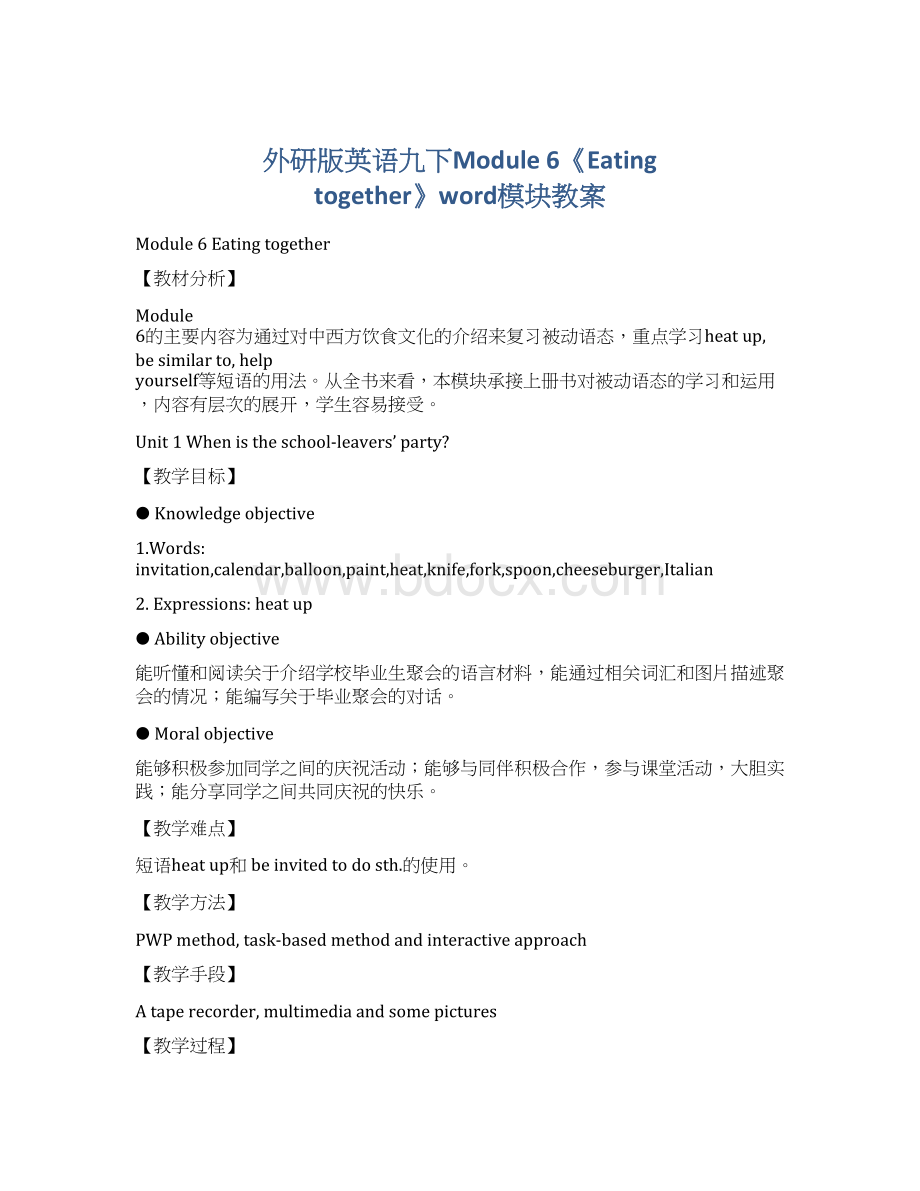外研版英语九下Module 6《Eating together》word模块教案.docx
《外研版英语九下Module 6《Eating together》word模块教案.docx》由会员分享,可在线阅读,更多相关《外研版英语九下Module 6《Eating together》word模块教案.docx(23页珍藏版)》请在冰豆网上搜索。

外研版英语九下Module6《Eatingtogether》word模块教案
Module6Eatingtogether
【教材分析】
Module6的主要内容为通过对中西方饮食文化的介绍来复习被动语态,重点学习heatup,besimilarto,helpyourself等短语的用法。
从全书来看,本模块承接上册书对被动语态的学习和运用,内容有层次的展开,学生容易接受。
Unit1Whenistheschool-leavers’party?
【教学目标】
●Knowledgeobjective
1.Words:
invitation,calendar,balloon,paint,heat,knife,fork,spoon,cheeseburger,Italian
2.Expressions:
heatup
●Abilityobjective
能听懂和阅读关于介绍学校毕业生聚会的语言材料,能通过相关词汇和图片描述聚会的情况;能编写关于毕业聚会的对话。
●Moralobjective
能够积极参加同学之间的庆祝活动;能够与同伴积极合作,参与课堂活动,大胆实践;能分享同学之间共同庆祝的快乐。
【教学难点】
短语heatup和beinvitedtodosth.的使用。
【教学方法】
PWPmethod,task-basedmethodandinteractiveapproach
【教学手段】
Ataperecorder,multimediaandsomepictures
【教学过程】
TeachingProcedures:
Step1Lead-in
Sslookthepicturesandanswerthequestions.
Isthisaninvitation?
Haveyoueverbeeninvitedtotheparty?
Whatwillyoutaketojointheparty?
Whatdoyouusuallydoattheparty?
Step2Consolidatenewwordsandexpression
Lookandsay.Theteachersshowsthepicturesofnewwordsandexpressions,thenletthestudentstosayasquicklyaspossible.
invitationn.邀请;请柬
calendarn.日历;历书
balloonn.气球
paintv.绘画
heatv.使变热;给……加热
knifen.餐刀;刀具
forkn.餐叉
spoonn.匙;勺子
cheeseburgern.干酪汉堡包
Italianadj.意大利的;意大利人的n.意大利语;意大利人
heatup使变热;给……加热
Step3Listening
1.Listenandcompletetheinvitation.
Invitation
Youareinvitedtothe_______________onSaturday,30thMayat____________in________________________________.Bringatraditionaldish(____________).Comeandenjoythefood,musicanddancing.
2.Nowworkinpairsandcheck.
Step4Listening
1.ListentoPart2andanswerthefollowingquestions.
1)WhatisDaminggoingtomake?
Jiaozi.
2)Whoisgoingtomakehotandsoursoup?
Lingling.
Step5Reading
1.Readthedialogueandcompletethenotes.
Dish
Lingling___________________
Betty___________________
Daming___________________
Tony___________________
Madewith…
Lingling_______________________
Betty________________________
Daming________________________
Tony________________________
2.Readthedialogueandanswerthequestions.
1.WhatwasDamingchosentodoattheschool-leavers’party?
2.Wherearetheygoingtopreparethefood?
3.WhydoesTonycallpizzaatraditionalEnglishdish?
Step6Completethepassagewiththewordsinthebox
1.Readthepassagecarefully.
2.Choosetherightwordsinthebox.
3.Drawtherightanswersfromeachgroup.
balloonscalendarfork
knifepaintspoon
Thedayfortheschool-leavers’partyisanimportantdateintheschool
(1)_________.Tonyisgoingtobringsome
(2)_________and(3)______________somepicturesfortheparty.Everyoneisgoingtobringatraditionaldishthatcanbeeatenwiththeirfingers.Soupisnogoodbecauseitisnotfingerfoodandpeopleneeda(4)_______forit.Anythingthatneedsa(5)_______and(6)_______isnotfingerfoodeither.
Step7EverydayEnglish
LetSssaywhattheyhavelearntinthepassage.
•Soup’snogoodthen.
•Andyou?
•Iseewhatyoumean.
Step8Languagepoints
SsshouldmasterthemainpointsfromthepassageinPart3.Ifpossible,letthestudentstosayatfirst.
1.Lookattheschoolcalendar!
看看学校的校历!
calendar表示“日历”,schoolcalendar表示“校历”。
e.g.Lookattheschoolcalendar!
Wewillhaveanexamnextweek.
看看学校的校历!
我们下周将有一次考试。
2.We’reallinvited.
我们都被邀请了。
这个句子为一般现在时的被动语态。
invite是动词,表示“邀请”。
invitation是名词,也表示“邀请”。
3.AndIwasaskedtobringsomeballoonsandpaintsomepicturesfortheparty.
我被要求带一些气球和为这个聚会画一些画。
balloon表示“气球”。
paint表示“绘画”,是动词。
e.g.Pleasepaintaballoonformeinthepaper.
请为我在纸上画一个气球。
4.Wecanheatitupintheschoolkitchen.
我们能在学校厨房加热它。
heatup表示“使变热,给…加热”。
e.g.Lightthecookerandheatupthefood.
点着厨具加热食物。
5.Theteachershaveaskedeveryonetoprepareatraditionaldishfromtheir
homecountry.
老师要求每人准备一道家乡的传统菜。
dish表示“烹制好的菜肴,一道菜”。
e.g.WhenIwasinItaly,Ihadawonderfulpastadish.
我在意大利的时候,吃过一次很棒的意大利面。
dish还表示“盘子”。
Dish的复数还可以表示“待洗的餐具”。
e.g.I’lldothedishesbeforewego.
我们走之前,我会把餐具洗好的。
6.Oh,soup’snogoodthen.
哦,汤不行。
nogood表示“不适合”。
e.g.Theseglassesarenogoodforchampagne.
这些玻璃杯不适合用来喝香槟。
nogood的用法有四条:
(1)itisnogooddoing做某事没用
e.g.It’snogoodtalkingtohim—heneverlistens.
跟他讲没用,他从来不听。
(2)nogoodforsth.不适合某物/某事
e.g.Thismedicineisnogoodforheadache.
这药治不了头痛。
(3)nogoodtosb.对某人没有好处或没有帮助
e.g.Acarisnogoodforme,sinceIcan’tdrive.
汽车对我没用,因为我不会开车。
(4)donogood没用处,不成功
e.g.I’lltalktohim,butitwilldonogood.
我会和他谈的,但不会有用。
7.Thatmeansyoueatitwithyourfingers,notwithaknife,forkorspoon.
那意味着你吃饭用你的手指,不会用刀、叉、勺子。
knife表示“餐刀”,复数为knives.
fork表示“餐叉”。
spoon表示“匙”。
aknifeandfork表示“一副刀叉”。
8.Issheinvitedtotheschool-leavers’partytoo?
她也被邀请参加学校的毕业晚会了吗?
bei